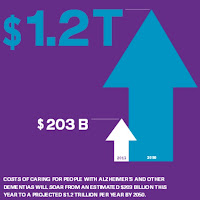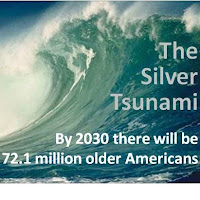VIDEO & ARTICLE
A new report shows major diseases such as heart disease, HIV/AIDS and stroke continue to decline significantly. Alzheimer’s, on the other hand, continues to rise. It increased 68% from 2000-2010. Learn about 2013’s facts and figures.
According to the Alzheimer’s Association 2013 Alzheimer’s Disease Facts and Figures report released today, one in three seniors dies with Alzheimer’s or another dementia in the United States. The new report shows that while deaths from other major diseases, such as heart disease, HIV/AIDS and stroke, continue to experience significant declines, Alzheimer’s deaths continue to rise — increasing 68 percent from 2000-2010.
Harry Johns, president and CEO of the Alzheimer’s Association, said, “1 in 3 seniors die with Alzheimer’s disease or another dementia. Urgent, meaningful action is necessary, particularly as more and more people age into greater risk for developing a disease that today has no cure and no way to slow or stop its progression.”
Alzheimer’s disease is the sixth-leading cause of death in the United States and is the only leading cause of death without a way to prevent, cure or even slow its progression. Based on 2010 data, Alzheimer’s was reported as the underlying cause of death for 83,494 individuals — individuals who died from Alzheimer’s. Alzheimer’s Association 2013 Facts and Figures reveals that in 2013 an estimated 450,000 people in the United States will die with Alzheimer’s. The true number of deaths caused by Alzheimer’s is likely to be somewhere between the officially reported number of those dying from and those dying with Alzheimer’s.
According to Alzheimer’s Association 2013 Facts and Figures, a recent study evaluated the contribution of individual common diseases to death using a nationally representative sample of older adults and found that dementia was the second largest contributor to death behind heart failure. Among 70-year-olds with Alzheimer’s disease, 61 percent are expected to die within a decade. Among 70-year-olds without Alzheimer’s, only 30 percent will die within a decade.
Human and Financial Toll of Alzheimer’s
More than 5 million Americans are living with Alzheimer’s disease. Without the development of medical breakthroughs that prevent, slow or stop the disease, by 2050, the number of people with Alzheimer’s disease could reach 13.8 million. Previous estimates suggest that number could be high as 16 million.
Alzheimer’s and dementia place an enormous burden on individuals and families. In 2012, there were more than 15 million caregivers who provided more than 17 billion hours of unpaid care valued at $216 billion. Individuals with dementia often require increasing levels of supervision and personal care as the disease progresses. As symptoms exacerbate as the disease progresses, the care required of family members and friends can often result in increased emotional stress and health challenges for caregivers. Due to the physical and emotional toll of caregiving, Alzheimer’s and dementia caregivers had $9.1 billion in additional health care costs of their own in 2012.
The burden on the nation’s health care system and government programs is also enormous. According to Alzheimer’s Association 2013 Facts and Figures, the total payments for health and long-term care services for people with Alzheimer’s and other dementias will total $203 billion in 2013, the lion’s share of which will be borne by Medicare and Medicaid with combined costs of $142 billion. Despite these staggering figures today, by 2050 total costs will increase 500 percent to $1.2 trillion.
2013 Health and Long-Term Care Services Breakdown
| Medicare | $107 billion | 53% |
| Medicaid | $35 billion | 17% |
| Out-of-Pocket Costs | $34 billion | 17% |
| Other Sources (HMO, Private Insurance, Managed Care Organizations and Uncompensated Care) |
$27 billion | 13% |
| Total | $203 billion |
“Alzheimer’s disease steals everything – steadily, relentlessly, inevitably. With baby boomers reaching the age of elevated risk, we do not have time to do what we have always done,” said Robert Egge, vice president of public policy for the Alzheimer’s Association. “The National Institutes of Health needs to reset its priorities and focus its resources on the crisis at our doorstep, and Congress must fully fund implementation of the National Alzheimer’s Plan to solve the crisis.”
Special Focus on the Long-Distance Caregiving Experience
2013 Facts and Figures also explores the challenges faced by long-distance caregivers for people living with Alzheimer’s. The report finds that nearly 15 percent of caregivers for people with Alzheimer’s or another dementia are “long-distance caregivers” — caring for people with Alzheimer’s disease who live at least 1 hour away. These long-distance caregivers had annual out-of-pocket expenses nearly twice as high as local caregivers — $9,654 compared to $5,055.
“The difficulties of Alzheimer’s and dementia are significant for all caregivers, but individuals who live a substantial distance from their loved ones face unique hardships,” said Beth Kallmyer, MSW, vice president of constituent services for the Alzheimer’s Association. “Long-distance caregivers have nearly double the out-of-pocket expenses of local caregivers, experience greater challenges assessing the care recipient’s conditions and needs, report more difficulty communicating with health care providers and often have higher levels of psychological distress and family discord in their caregiving experience.”
The Alzheimer’s Association offers a variety of educational and support resources, including its 24/7, toll-free Helpline (1.800.272.3900), care consultation and online resources to assist families with the care management of someone living with Alzheimer’s regardless of geography. ALZConnected™, powered by the Alzheimer’s Association, is a social networking community for people with Alzheimer’s, caregivers and others affected by the disease to share questions and form new connections. Users can tap into a diverse community through the site’s message boards and create private groups organized around specific topics.
Alzheimer’s Navigator™ is a tool designed to help individuals with the disease, caregivers and family members evaluate their needs and develop a customized action plan that provides information, support and resources. Alzheimer’s Navigator works in conjunction with Community Resource Finder, a comprehensive database of housing and care options, programs and services, and legal experts, allowing users to quickly search, find and access support. Users can also create and manage care teams so that multiple people can access and participate in the customized action plan.
The full text of the Alzheimer’s Association 2013 Alzheimer’s Disease Facts and Figures can be viewed at www.alz.org.
The full report will also appear in the March 2013 issue of Alzheimer’s & Dementia: The Journal of the Alzheimer’s Association (Volume 9, Issue 2).
MORE INFORMATION:
Alzheimer’s Association
The Alzheimer’s Association is the world’s leading voluntary health organization in Alzheimer care, support and research. Our mission is to eliminate Alzheimer’s disease through the advancement of research; to provide and enhance care and support for all affected; and to reduce the risk of dementia through the promotion of brain health. Our vision is a world without Alzheimer’s. For more information, visit www.alz.org.













We must reinvent the curriculum in medical, nursing, and allied health schools to better understand identification of dementias and both pharmacologic and behavioral interventions that can effectively provide the highest quality of life.
Mark Elliott Miller, MPH